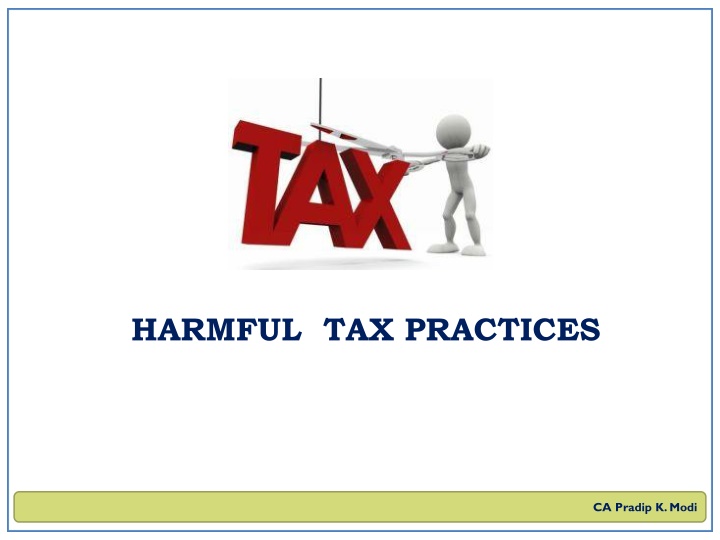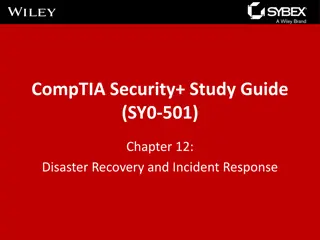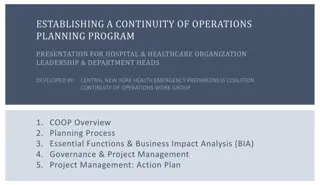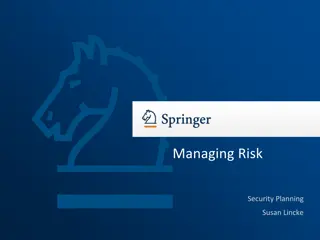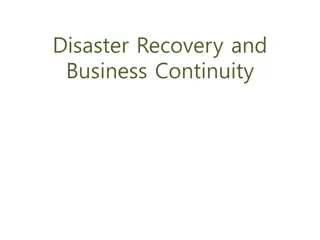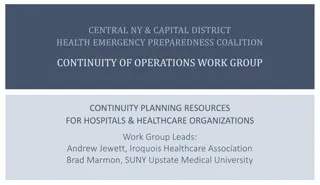Business Continuity Planning and IT Risk Management - Framework and Guidelines
BCP, or business continuity planning, aims to prevent threats and ensure recovery in disasters. It involves defining disaster scope, assigning managers, identifying resources, testing procedures, and more.
Download Presentation

Please find below an Image/Link to download the presentation.
The content on the website is provided AS IS for your information and personal use only. It may not be sold, licensed, or shared on other websites without obtaining consent from the author.If you encounter any issues during the download, it is possible that the publisher has removed the file from their server.
You are allowed to download the files provided on this website for personal or commercial use, subject to the condition that they are used lawfully. All files are the property of their respective owners.
The content on the website is provided AS IS for your information and personal use only. It may not be sold, licensed, or shared on other websites without obtaining consent from the author.
E N D
Presentation Transcript
HARMFUL TAX PRACTICES CA Pradip K. Modi
INTRODUCTION Today s more open, competitive commercial environment has benefited households and businesses around the world by lowering the cost of capital and providing greater choices for consumers. The removal of trade barriers and the resulting increased competition has created new opportunities for growth and stimulated greater efficiency in the operation of financial and other markets. At the same time, a more liberalised global economy presents challenges for governments, including in the tax area. One of the challenges governments face is ensuring that their tax systems remain competitive and do not act as a barrier to increased productivity. The wave of tax reform that has swept through OECD and other countries over the last 15 years has been driven in part by the desire to achieve this goal. Personal and corporate income tax rates have been significantly reduced, particularly in Europe, and the tax base has been widened to remove many tax-induced distortions. The global economy will not reap the full benefits of this more competitive environment unless the competition between countries is based upon transparent and internationally accepted standards, including standards of international cooperation in tax matters necessary to counter the increased cross border opportunities to unlawfully avoid or evade national taxes enacted by democratically elected legislatures. 1 CA Pradip K. Modi
INTRODUCTION Contd.. Tax Heavens and Harmful preferential tax regimes, collectively referred to as harmful tax practices, affect the location of financial and other service activities, erode the tax bases of other countries, distort trade and investment patterns and undermine the fairness, neutrality and broad social acceptance of tax systems generally. Such harmful tax competition diminishes global welfare and undermines taxpayer confidence in the integrity of tax systems. The Organisation for Economic Co-operation and Development (OECD) published its report Harmful Tax Competition: An Emerging Global Issue ( OECD Report ). The Report identified for the first time two problem areas facing international income taxation of geographically mobile activities: Tax Heavens; and Harmful Preferential Tax Regimes It sought to initiate activities to eliminate both types of problems. 2 CA Pradip K. Modi 3
TAX HEAVEN A Tax Heaven is a country that offers Foreign Individuals and Businesses a minimal Tax Liability in a politically and economically stable environment, with little or no financial information shared with foreign tax authorities. A Tax heaven is essentially a jurisdiction which serves as a means by which firms and individuals resident in other jurisdictions can escape the taxes that they would otherwise be obliged to pay in their resident jurisdictions. Tax heavens do not require individuals to reside in or businesses to operate out of their countries to benefit from local tax policies. Tax haven status benefits the host country as well as the companies and individuals maintaining accounts in them. Tax haven countries benefit by drawing capital to their banks and financial institutions, which can form the foundation of a thriving financial sector. Individuals and corporations benefit through tax savings resulting from tax rates ranging from zero to the low single digits versus relatively high taxes in their countries of citizenship or domicile. 3 CA Pradip K. Modi 4
TAX HEAVEN Contd.. The list of tax haven countries includes Andorra, the Bahamas, Belize, Bermuda, the British Virgin Islands, the Cayman Islands, the Channel Islands, the Cook Islands, Hong Kong, The Isle of Man, Mauritius, Lichtenstein, Monaco, Panama, and St. Kitts and Nevis. Factors to Indentify Tax Heavens: The Necessary starting point to identify a tax heaven is to ask Whether a jurisdiction imposes no or only nominal taxes and offers itself, or is perceived to offer itself , as a place to be used by non-residents to escape tax in their country of residence; Laws or administrative practices which prevent the effective exchange of relevant information with other governments on taxpayers benefiting from the low or no tax jurisdiction; Lack of Transparency; and The absence of a requirement that the activity be substantial, since it would suggest that a jurisdiction may be attempting to attract investment or transactions that are purely tax driven. (a) (b) (c) (d) 4 CA Pradip K. Modi 5
HARMFUL PREFERENTIAL TAX REGIMES A preferential tax regime is a targeted tax regime wherein, the country might operate a normal tax system, but exempt specified classes of income from tax or subject them to tax at lower rates. Preferential tax regimes are generally part of the tax legislation of countries with a standard corporate income tax design. The preferential tax regime offers a benefit In comparison with the standard tax rules in that relevant country. Many countries offer preferential tax regimes for different types of entities or activities. Preferential tax regimes can result from both a reduced tax rate as well as a reduction in the tax base. The OECD report on harmful tax competition stated four key factors and eight other factors as identifying factors of a harmful preferential tax regime. The Four key factors were as follows: A Low or Zero effective tax rate on specified kind of income Ringfencing of Regimes 1. 2. 5 CA Pradip K. Modi 6
HARMFUL PREFERENTIAL TAX REGIMES Contd. Lack of Transparency No effective exchange of information with other governments. 3. 4. The Eight other factors were as follows: An artificial definition of the Tax Base A Failure to adhere to International Transfer Pricing Principles The Exemption of foreign-source Income tax Negotiable tax rates or tax bases The essential difference between a tax haven and a harmful preferential regime is that a tax haven does not have any tax base to protect and does not have any interest in preventing harmful tax competition which is not the case with harmful preferential tax regimes. Typical examples of preferential tax regimes are the following, IP box regimes, regimes which provide preferential tax treatment for income from qualifying intellectual property or IP. Interest box regimes. Regimes benefiting certain industries or activities for example, banking, shipping, financing, insurance, electronic commerce, or headquarter activities. 1. 2. 3. 4. 6 CA Pradip K. Modi 7
Assessing the Economic Effects of a Potential Tax Regime in Terms of its Potential Harmfulness As per the OECD Committee, when examining a regime it is helpful to pose a number of questions as to its economic effects. The following three questions should be pose: Does the regime shift activity from one country to the country providing the preferential tax regime, rather than generate significant new activity? Is the presence and level of activities in the host country commensurate with the amount of investment or income? Is the preferential tax regime the primary motivation for the location of an activity? 1. 2. 3. 7 CA Pradip K. Modi 8
